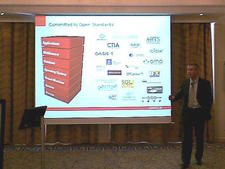Oracle Goes with Own DB, SPARC and UNIX
In Munich, Wednesday, March 10, Oracle announced its upcoming strategy for the Sun takeover: the new couple will now sell complete packages and, next to Oracle's database, further develop Solaris along with Sun's SPARC and Flashfire server technologies.
Managing director of Oracle Germany, Juergen Kunz, described the situation at Oracle, which had some time to ferment after the European Union's investigation of the takeover, as such: language inside the company includes words like "pregnancy" and "bringing up baby." Sun brings a "totally new dimension." The portolio is "unique" and "no other company can provide the same." Dermot O'Kelly, Oracle's vice president for hardware in Europe, put the situation in concrete terms with the new "Oracle Stack."
Oracle Wrap
The stack starts on the hardware side with storage, servers and virtual machines under the motto "Complete, open, integrated," continues with operating systems and databases and goes to middleware and applications. The message is clear: the more a customer buys an integrated system from Oracle, the better the results. Existing infrastructure elements can even be integrated.
 Open standards got their own slide in Dermot O'Kelly's presentation. The "Oracle Stack" is clearly shown on the left.
Open standards got their own slide in Dermot O'Kelly's presentation. The "Oracle Stack" is clearly shown on the left.
O'Kelly was proud of the first products to be whipped up in the mix of Oracle and Sun competencies. The Bolide Exadata v2 first announced in September, 2009 and a database machine with Sun hardware and Oracle software should give IBM a run for its money. The hardware VP feels that Oracle will "stir up the market" in the future with the combined products.
Rolf Kersten, marketing manager at Sun Microsystems, outlined what it all should look like. Oracle will no longer just consider itself first in databases, but also in the UNIX server market. Oracle wants to invest more than Sun previously in the Solaris "technology diamond" and SPARC processors. Even the x86 machines will be further developed as elements of integrated systems as well as freestanding solutions. All hardware will be optimized for the Oracle database, for which the company is promising large performance gains.
MySQL? Yes, but...
Asked by Linux Magazine Online if the same sort of strategy exists for MySQL setups, for example, Kersten, who has been at Sun for 12 years, responded with "yes," but only after repeated questioning. His first responses included words like "third-party" and "certification." Finally he committed to the statement, "MySQL ultimately belongs to the inhouse products." Until further notice, let the answer to the MySQL question be interpreted as "yes, but..."
 The Oracle event in Munich on March 10, "Welcome Event Oracle + Sun: Transforming the IT Industry," was well attended by (potential) customers.
The Oracle event in Munich on March 10, "Welcome Event Oracle + Sun: Transforming the IT Industry," was well attended by (potential) customers.
Insiders believe that Oracle will deploy its own database and MySQL in different segments and therefore not get into an internal rivalry. These sources don't consider Oracle's MySQL coming into much play in the high-end segment. Other observers see parallels between Oracle's Sun acquisition and that of SUSE by Novell: a license-oriented enterprise pulls in another open-source-oriented one and behaves awkwardly as a consequence.
The event did unfortunately reveal that Oracle is unlikely to include Linux or open source as strategic advantages in the marketplace, even though the company quite recently maintained that it understood the open source principle better than did the European Commission. Open standards did deserve mention, but it's more likely that the open source divisions with MySQL, OpenOffice and the free Java components will continue to get niche status. Commitments to the projects are nevertheless real.
Subscribe to our Linux Newsletters
Find Linux and Open Source Jobs
Subscribe to our ADMIN Newsletters
Support Our Work
Linux Magazine content is made possible with support from readers like you. Please consider contributing when you’ve found an article to be beneficial.

News
-
Parrot OS Switches to KDE Plasma Desktop
Yet another distro is making the move to the KDE Plasma desktop.
-
TUXEDO Announces Gemini 17
TUXEDO Computers has released the fourth generation of its Gemini laptop with plenty of updates.
-
Two New Distros Adopt Enlightenment
MX Moksha and AV Linux 25 join ranks with Bodhi Linux and embrace the Enlightenment desktop.
-
Solus Linux 4.8 Removes Python 2
Solus Linux 4.8 has been released with the latest Linux kernel, updated desktops, and a key removal.
-
Zorin OS 18 Hits over a Million Downloads
If you doubt Linux isn't gaining popularity, you only have to look at Zorin OS's download numbers.
-
TUXEDO Computers Scraps Snapdragon X1E-Based Laptop
Due to issues with a Snapdragon CPU, TUXEDO Computers has cancelled its plans to release a laptop based on this elite hardware.
-
Debian Unleashes Debian Libre Live
Debian Libre Live keeps your machine free of proprietary software.
-
Valve Announces Pending Release of Steam Machine
Shout it to the heavens: Steam Machine, powered by Linux, is set to arrive in 2026.
-
Happy Birthday, ADMIN Magazine!
ADMIN is celebrating its 15th anniversary with issue #90.
-
Another Linux Malware Discovered
Russian hackers use Hyper-V to hide malware within Linux virtual machines.
